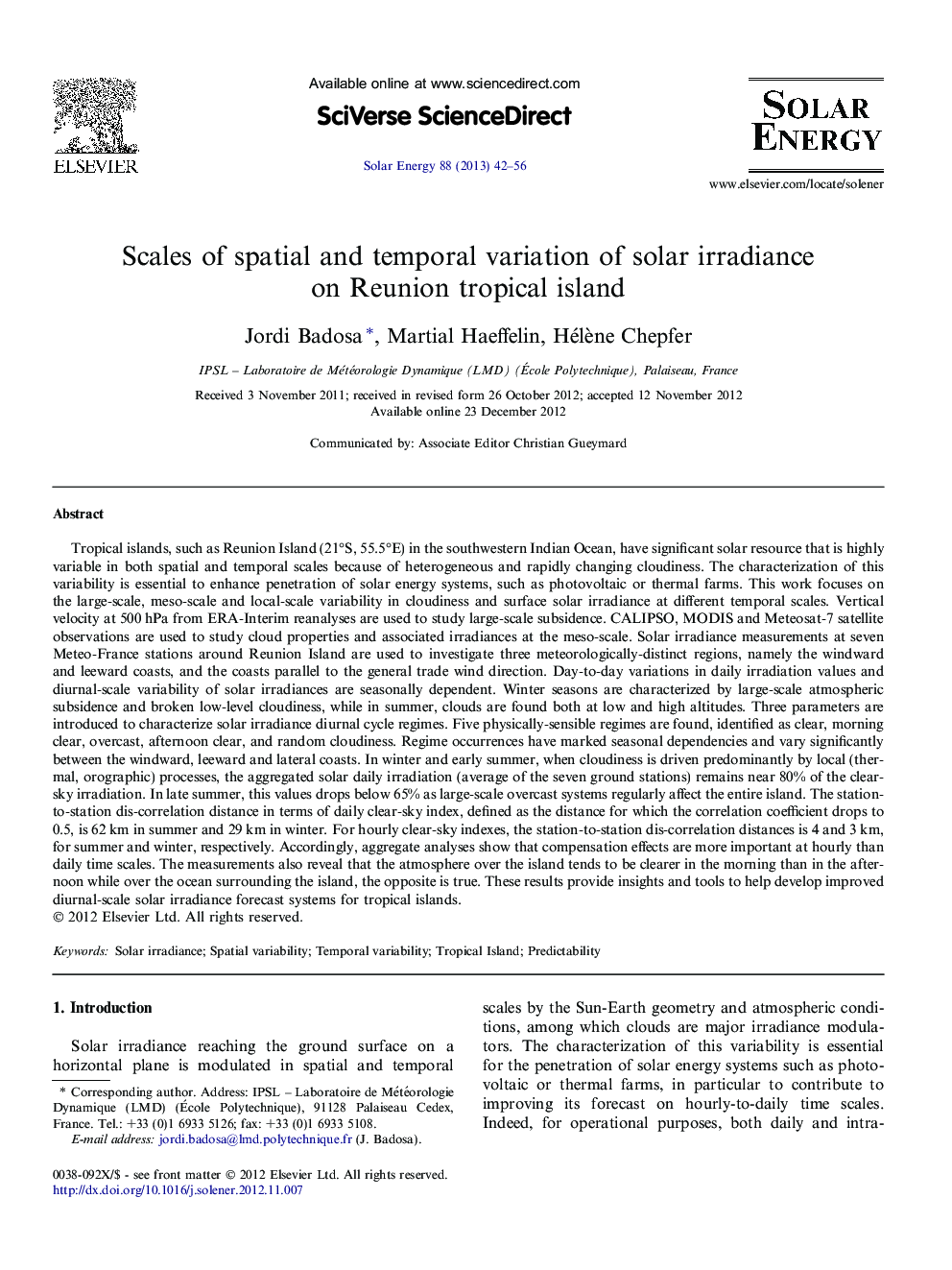| کد مقاله | کد نشریه | سال انتشار | مقاله انگلیسی | نسخه تمام متن |
|---|---|---|---|---|
| 1550648 | 1513129 | 2013 | 15 صفحه PDF | دانلود رایگان |

Tropical islands, such as Reunion Island (21°S, 55.5°E) in the southwestern Indian Ocean, have significant solar resource that is highly variable in both spatial and temporal scales because of heterogeneous and rapidly changing cloudiness. The characterization of this variability is essential to enhance penetration of solar energy systems, such as photovoltaic or thermal farms. This work focuses on the large-scale, meso-scale and local-scale variability in cloudiness and surface solar irradiance at different temporal scales. Vertical velocity at 500 hPa from ERA-Interim reanalyses are used to study large-scale subsidence. CALIPSO, MODIS and Meteosat-7 satellite observations are used to study cloud properties and associated irradiances at the meso-scale. Solar irradiance measurements at seven Meteo-France stations around Reunion Island are used to investigate three meteorologically-distinct regions, namely the windward and leeward coasts, and the coasts parallel to the general trade wind direction. Day-to-day variations in daily irradiation values and diurnal-scale variability of solar irradiances are seasonally dependent. Winter seasons are characterized by large-scale atmospheric subsidence and broken low-level cloudiness, while in summer, clouds are found both at low and high altitudes. Three parameters are introduced to characterize solar irradiance diurnal cycle regimes. Five physically-sensible regimes are found, identified as clear, morning clear, overcast, afternoon clear, and random cloudiness. Regime occurrences have marked seasonal dependencies and vary significantly between the windward, leeward and lateral coasts. In winter and early summer, when cloudiness is driven predominantly by local (thermal, orographic) processes, the aggregated solar daily irradiation (average of the seven ground stations) remains near 80% of the clear-sky irradiation. In late summer, this values drops below 65% as large-scale overcast systems regularly affect the entire island. The station-to-station dis-correlation distance in terms of daily clear-sky index, defined as the distance for which the correlation coefficient drops to 0.5, is 62 km in summer and 29 km in winter. For hourly clear-sky indexes, the station-to-station dis-correlation distances is 4 and 3 km, for summer and winter, respectively. Accordingly, aggregate analyses show that compensation effects are more important at hourly than daily time scales. The measurements also reveal that the atmosphere over the island tends to be clearer in the morning than in the afternoon while over the ocean surrounding the island, the opposite is true. These results provide insights and tools to help develop improved diurnal-scale solar irradiance forecast systems for tropical islands.
► We study the variability of solar irradiation at Reunion Island, S–W Indian Ocean.
► Reanalyzes, satellite (large/meso scale) and ground station (local) data are used.
► Winters are under subsidence, with no high clouds and solar irradiance less variable.
► Five daily regimes are defined Clear/AMClear/PMClear/Overcast/Random).
► Very important spatial variability found which is marked by the trade wind direction.
Journal: Solar Energy - Volume 88, February 2013, Pages 42–56